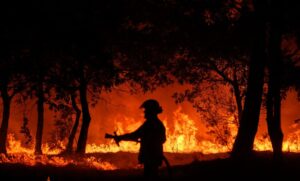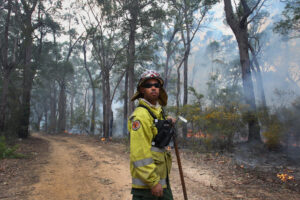In a land of extremes, nowhere in the Arctic does the temperature oscillate more wildly than the tiny settlement of Fort Yukon in north-eastern Alaska. This village — of a few hundred residents belonging to the indigenous Gwich’in community, and which is only accessible by air, boat or snowmobile, depending on the time of year — has the distinction of being both the coldest and warmest place in Alaska.
In 1947, the mercury here plummeted to -62.8ºC, so cold that reportedly frozen droplets of moisture in exhaled breath tinkled to the floor like shards of broken glass. In the summer of 1915, meanwhile, temperatures reached 37.8ºC, a record that stands to this day. Over the past 40 years, as the Arctic has warmed at a rate anything up to four times faster than the rest of the planet, the Yukon Flats, which straddle the Arctic Circle, have recorded the biggest temperature increases of all. Winters here are now on average 4.9ºC warmer than they were in the Fifties. In summer, the vast forests of spruce which span the Gwich’in territory are routinely ablaze.
Edward Alexander, a 46-year-old co-chair of the Gwich’in Council International, grew up in Fort Yukon and now lives in the Alaskan city of Fairbanks. For the past eight years, the father-of-four has worked as a volunteer firefighter, helping to tackle the devastating wildfires ravaging the Arctic and boreal north. This year, Canada has already registered its worst wildfire season on record, which has destroyed more than 52,000 square miles of the country — an area greater than the size of England. In Alaska, meanwhile, the frequency of wildfires exceeding one million acres in size has doubled in the past 30 years.
Alexander estimates that wildfires have claimed around four million acres of Gwich’in land since the Fifties, and in summer a thick band of smog often blankets the Yukon Flats. “We have had a front row seat to the beginning of the Pyrocene, as they are starting to call it,” he says. “The burning of the world.” Rain now falls instead of snow, caribou herds on which the Gwich’in rely have changed their patterns of migration, the rivers have warmed and salmon populations collapsed. And as the ice recedes, outside interests have started eying up the natural resources underneath the melting permafrost. After a deal was struck in 2019, oil and gas prospectors are currently scoping out the Yukon Flats.
A similar story is being recorded right across the High North. “Arctic amplification” is the term meteorologists use for the accelerated rate of global warming. But the same amplification is occurring with the geopolitics of the region. The Arctic is melting — one scientific study, published in June, claimed that the first summer in which all sea ice disappears could occur as early as the 2030s — and, from China to the US to Putin’s Russia, suddenly everyone wants a piece. The era of “Arctic exceptionalism” declared by Russian president Mikhail Gorbachev in 1987 is resolutely over, his entreaties for the Arctic to remain a “zone of peace” free from conflict and exploitation forgotten. As climate change accelerates and Russia’s invasion of Ukraine has cleaved apart the international order, the Arctic has emerged as the potential theatre of the next global conflict.
Alexander, who also represents the Gwich’in on the Arctic council (which includes the eight Arctic states, Canada, Denmark, Sweden, Norway, Finland, Iceland, the US and Russia) warns that the global race to plunder the Arctic could have devastating consequences. “If you don’t co-operate on the Arctic and we don’t get these things right, then I’ll tell you this, my friend: the world can change very rapidly.”
Russia, whose territory spans around 53% of the Arctic Ocean shoreline, and China are rapidly developing plans to expand the Northern Sea Route. The maritime passage between the east and west of the Arctic Ocean is regarded by the Kremlin as vital to avoid Western sanctions. It is already possible to navigate the route for anyone with several briefcases full of dollars to pay for the mandatory Russian ice breakers which accompany any transit as patrol vessels. In 2024, the Kremlin is planning to commence year-round navigations of the route, through which it hopes to increase the amount of cargo shipped from around 30 million annually to 80 million.
China — which has ominously declared itself a “near-Arctic state” — also harbours ambitions to transform the passage into a silk road of the far north, while in March, a Russian delegation to India held talks over new co-operation over the route. The West is similarly flexing its muscles, with Finland (and the expected accession of Sweden) extending Nato’s borders into the Arctic. In June, the US Secretary of State Anthony Blinken announced that the US would be opening an outpost in the far-north Norwegian town of Tromsø, stressing the need to have “a diplomatic footprint” above the Arctic Circle. “The war in Ukraine has really torpedoed this idea of Artic exceptionalism,” explains Dr Neil Melvin, Director of International Security at the Royal United Services Institute (RUSI). “The whole focus of northern Europe has basically now shifted to building security against Russia.”
As Melvin points out, the heavy losses sustained by Russia’s land army in Ukraine will force it to become increasingly reliant on its nuclear forces stationed in the Arctic, where the UK and US have also long operated their own attack submarines. Russia’s Northern Fleet comprises of a dozen or so nuclear-powered attack submarines as well as surface vessels, including two heavy nuclear-powered missile battle cruisers. In recent years, Russia has also reoccupied old Cold War-era Arctic bases to bolster its presence. “They will feel more vulnerable as a result of not having a strong army, and I think we are likely to see them threaten nuclear options much more as part of national defence,” Melvin says of Russia’s designs in the Arctic. “They are going to be much more explicit and threatening.”
Beneath the ice, the Arctic possesses untold riches. The region is estimated to contain a fifth of the world’s undiscovered oil and gas reserves and rare earth elements such as gold, nickel and zinc. While most of these are present within the largely undisputed land borders of the Arctic nations, it is the increasingly navigable international waters that present the most likely flashpoint. An ongoing process led by a United Nations commission is considering sovereignty rights to the central Arctic Ocean between Russia, Denmark and Canada. While Putin is cooperating with the process so far, he has also planted a flag in the most literal sense — dropping a titanium standard of the Russian Federation two miles beneath the ocean on the North Pole seabed in 2007. Fishing rights are also key; as southern oceans heat up, species will migrate ever further north, causing estimated catches in higher latitudes to increase by up to 20 per cent by 2050.
According to Professor Klaus Dodds, an expert in geopolitics and ice studies based at Royal Holloway and author of the recent book, Border Wars, the Norwegian archipelago of Svalbard could prove another area of conflict. Under a treaty originally signed in 1920, a host of countries including China and Russia have rights to engage in commercial activities across Svalbard. Moscow conducts coal mining operations on the island of Spitsbergen (and insists on referring to Svalbard by the same name, to emphasise its historic claim on the land). In settlements such as Barentsburg, Russian is the predominant language.
“The concern is we know we have potential flashpoints like Svalbard which, having caused agitation and tension in the past, might be escalated very quickly,” Dodds says. Aggression could be anything from attacks on underwater cables (last year, a Russian trawler was linked to the severing of a sub-sea fibre-optic cable which linked Svalbard to the Norwegian mainland), to an outright attack on oil and gas infrastructure. “The Norwegian European Arctic will be the space where, if anything, this is most likely to happen,” Dodds says. “That would also be the ultimate opportunity for Russia to test Nato’s resolve.”
Regardless of the potential for nuclear conflict, a burning Arctic poses grave threats for humanity. The Arctic permafrost contains peatland soils which are the world’s most vital carbon sink. Globally, peatlands store twice as much carbon as all the forests combined. When this burns, it releases the carbon back into the atmosphere creating something of a doom loop. According to the Copernicus Atmosphere Monitoring Service, wildfires across Canada have released 290 megatons of carbon into the atmosphere between January and August, more than 25% of the global total for 2023 in the year to date.
Thawing permafrost is also exposing chemical and radioactive waste and millennia-old “zombie viruses”. In 2016, around 100,000 reindeer were culled in the Russian far north after an anthrax outbreak that killed a 12-year-old boy. Plague bacillus, smallpox and other historic diseases are also feared to soon re-emerge from the melting earth. The discovery earlier this summer of 46,000-year-old roundworms lying dormant in Siberia, which are happily reproducing once again, may hold clues for adapting to climate change — but they also raise questions about what else might venture forth in a thaw. And herein lies the great lesson of the far north, Professor Dodds explains: nothing here ever happens in isolation — there will be wider ramifications across the globe. “Change in the Arctic is never restricted to the Arctic itself,” he says. “It is almost as if the Arctic strikes back.”
The time is long gone where we could think of the Arctic as a great pristine wilderness. Instead it has become the burning crucible of our climate crisis. But, as the towering glaciers melt and the seas of the Earth’s fifth largest ocean are revealed to us at last, their future looks even darker still, reanimating the biological threats of our deep past, and providing yet another site for human competition and conquest.
Disclaimer
Some of the posts we share are controversial and we do not necessarily agree with them in the whole extend. Sometimes we agree with the content or part of it but we do not agree with the narration or language. Nevertheless we find them somehow interesting, valuable and/or informative or we share them, because we strongly believe in freedom of speech, free press and journalism. We strongly encourage you to have a critical approach to all the content, do your own research and analysis to build your own opinion.
We would be glad to have your feedback.
Source: UnHerd Read the original article here: https://unherd.com/



